|
Cayley Table Pattern for Quarternion
group H
The quarternions group consists of 8 elements 1, -1, i, -i, j, -j, k, and -k, with the multiplication
identities of
The labeling of i, j, and k is unique only up to
automorphisms. Thus the same block pattern is used for each.
The H group is also known as Q8.
Another famous pattern, a.k.a. a dihedral group,
features the symmetries of a triangle.
D3
(order 6, triangle)
|
Dr. Fisher's Quilt
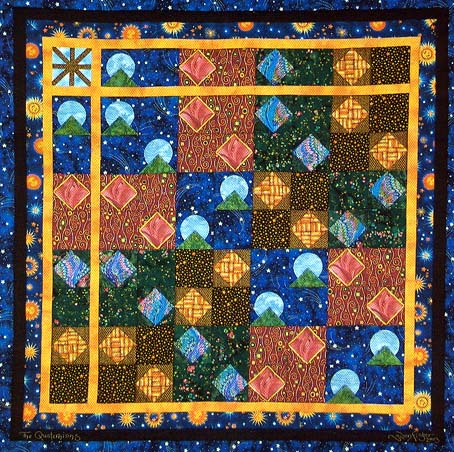
Quilts
are constructed by joining small "pieces" into "squares."
The identity element for this quilt is the Moon over the Moutain square.
As for color, each element is the same color as its corresponding
negative element: 1 and -1 are both blue, i and -i
are red, j and -j are green, and k and -k
are both gold and black.
The quilt also shows the normal subgroup { 1. -1 } and its four cosets
represented by the four colors. This in turn shows a factor group
of H
isomorphic to the Klein 4-subgroup.
One last property that is easily seen in this representation is that
the quaternions group is not commutative. The quilt and tables do
not have reflectional symmetry across the main diagonal.
|
Cayley Table Pattern for the whole H group intersecting D4.
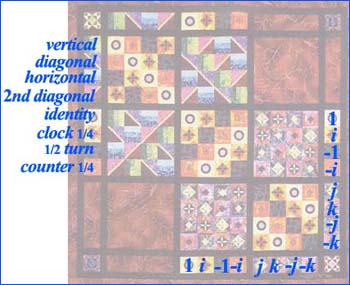
The eight elements of D4
are displayed down the left and across the top. The patterns are
as follows:
(1) vertical line of reflection
(2) diagonal line of reflection (top left to bottom right)
(3) horizontal line of reflection
(4) second diagonal line of reflection (bottom left to top right)
(5) identity
(6) clockwise quarter turn
(7) half turn
(8) counter clockwise quarter turn
The eight elements of H are
labeled across the bottom and on the lower right side.
The intersection of D4 and H:
|
Dr. Fisher's Second Quilt
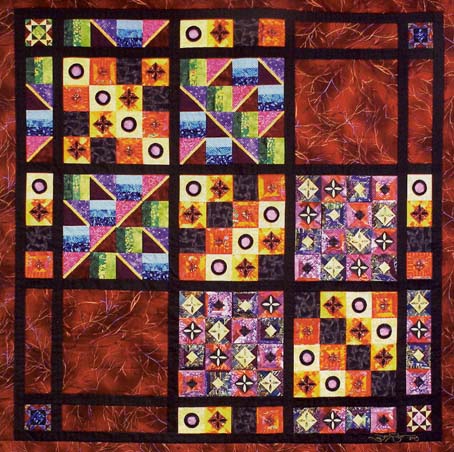
The whole H intersects D4
quilt.
The identity
element for both groups looks like a zero,  . The
quilt block for each of the four lines of reflectional symmetry
contains that attribute and the blocks with quarter turn elements each
have the quarter-turn rotational symmetry. . The
quilt block for each of the four lines of reflectional symmetry
contains that attribute and the blocks with quarter turn elements each
have the quarter-turn rotational symmetry.
Each element in the quarternions has the same coloring as its negative
element: i and -i are both red on
orange, j and -j are both cream on navy, and k
and -k are both black on purple.
The half turn in D4 always
corresponds with -1 in H and is a
black square in the quilt.
The ordering of the elements of D4 and H was chosen so that a cyclic subgroup K of order four forms the intersections of
the two multiplication tables. Here, K is
generated by the quarter turn in D4 and by i in H.
The two-by-two substructure in each of D4 and H shows the
cosets of the normal subgroup K of each
of the two groups. |
|
|
For
all viewers . . . .
Viewers
interested in quarternions will want to visit the NCB web page showing
the Broom Bridge in Dublin, Ireland where Sir William Rowan Hamilton
first formulated this group's structure. The name "H"
honors Hamilton's highly original contributions.
|
 |
"Quilts" based on Cayley
table patterns is an introduction to a sophisticated topic in
mathematics called Group Theory.
|
Fisher, Gwen L., The Quaternions
Quilts,
FOCUS, The Newsletter of the Mathematical Association of
America, vol. 25 (4), January, 2005, p. 4.
|
|
For the student . . . .
Each quilt piece represents
one of the objects in a Group. If group G has 8 elements, then
you will have 8 different pieces quilted together to form a 8 x 8
"square." Similarly, the Cayley table for this group will have 64
entries.
Cayley tables are studied in an
advanced topic of mathematics named Group Theory. Some historical background will enrich your
understanding. In past centuries, the Arab world contributed
equation theory leading to the powerful tool of symbolic manipulation.
The Greeks provided proof - the axiomatic method for codifying
important aspects of algebraic systems. One of the most notable
intersections of these two great mathematical approaches occurs in the
theory of groups. Briefly, Group Theory is a comprehensive
analysis of the concept of symmetry.
Group Theory is an area of active
research in pure mathematics that is widely applied in the sciences.
In particular, physicists, chemists and biologists use Group
Theory to elucidate the structures of crystalline solids as well as
isolated molecules. Group Theory has also been applied to predict
the reactivity patterns of chemical compounds.
A quilt is a plane surface. The
inquisitive student might ask,
just as Gauss and Hamilton wondered:
|
If
two-dimensional complex numbers
may be represented on a plane, and can be multiplied and divided in
such an exquisite way, is it not possible to try the same for three
dimensions using
three-dimensional vectors? |
Gauss and Hamilton were never able to give a conclusive answer.
The investigation of this question inspired massive developments in
modern
abstract algebra extending well into the 20th century when its
impossibility was finally established.
The
novice may also want to explore the connection between Cayley tables,
quilt patterns and modular, or "clock" arithmetic. |
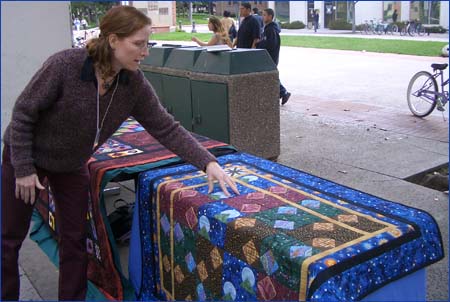
|
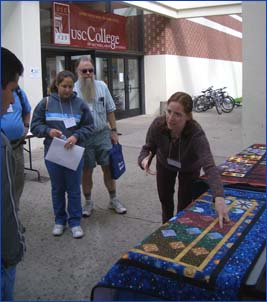 |
| Dr. Fisher explaining her quilts at
the Southern California-Nevada Section of the Mathematical Association
of American Spring 2005 Meeting. |
|
